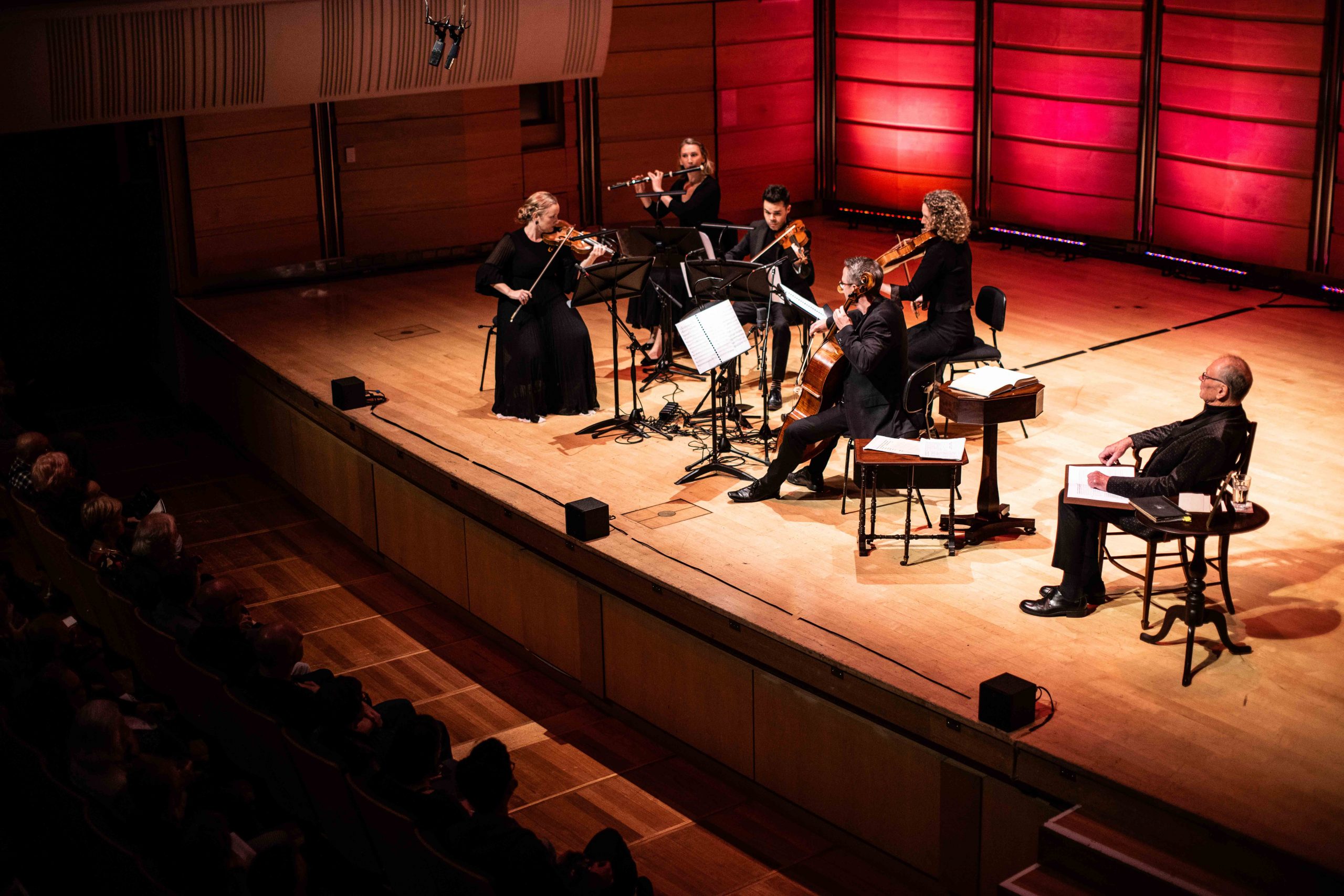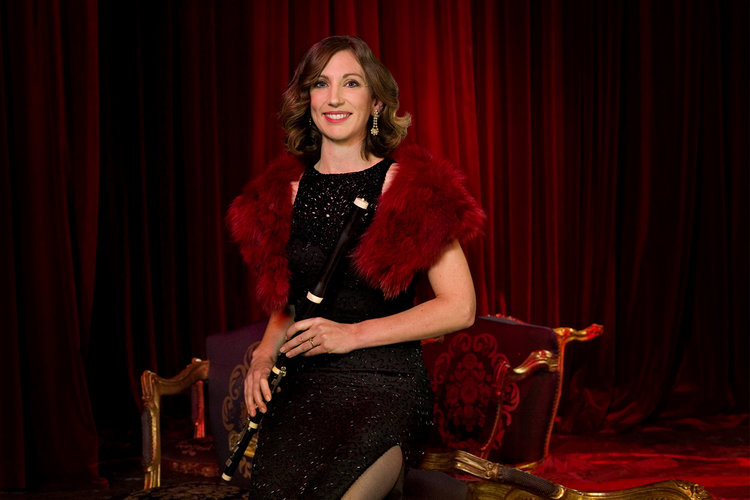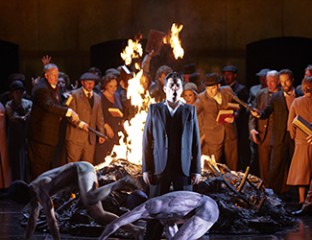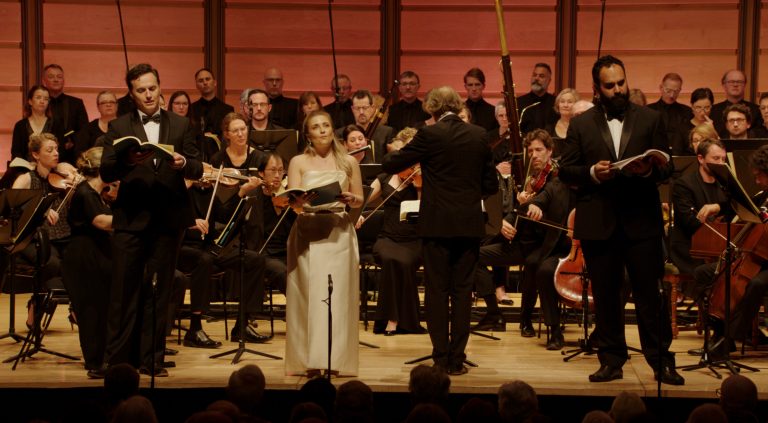Review: Haydn Speaks/ Australian Haydn Ensemble/John Bell
Haydn Speaks/ Australian Haydn Ensemble/ John Bell
City Recital Hall,
16 October, 2022
The Australian Haydn Ensemble’s production of Haydn Speaks joined the trend of redefining and re-imagining chamber music by deftly interweaving theatrical elements into the musical performance.
Haydn Speaks combined excerpts from the string quartets and symphonies of Franz Josef Haydn with a narrative, creating a nearly-two-hour journey through the life of this composer who made such a mighty and indelible mark on the body and history of Western classical music.
Acclaimed thespian John Bell clad in concert black, took on the persona of Josef Haydn in this account of the events and features of Haydn’s life, with the musicians comprising Artistic Director Skye McIntosh leading finely from her 1770 Neapolitan Eberle violin, Matthew Greco playing second violin, Karina Schmitz the viola, Daniel Yeadon the cello and Melissa Farrow playing transverse flute.
The stage, bathed in calm lighting designed by Saint Clair had a few props to embellish Bell’s monologue, but they were hardly required and didn’t look sufficiently aged. The soft golden lighting of the opening set was perfect for peering into history as musicians and actor, directed by Damien Ryan, realised Rachel McDonald’s carefully researched script and adaptation of real and fictional letters and diaries chronicling the life of Haydn.
Haydn’s musical output was prolific across small and large forms, from solo sonatas to symphonies and oratorios; he was inventive both at the structural level and in his ability to draw pictures, events and humour in music. His influence on the symphony and the string quartet are enduring. He was man of the people who worked for princes. He was creative, adventurous and funny. Encapsulating the character of Haydn, Bell’s delivery and McDonald’s script drew regular giggles and belly laughs from the audience. Threading its way through the narrative and unifying it into a whole was the concept of creating ‘something from nothing.’
The program was bookended by the first and last movements of Haydn’s Symphony No 104 in D major (London). The ensemble drew its bows and began the sombre Adagio fanfare of the London symphony, moving to a bustling Allegro as Bell came on stage and began the tale of Haydn’s life from his humble birth into the family of a wheelwright through his time as a gifted treble and prankster in the choir at St Stephen’s’ Cathedral in Vienna, to the nearly three-decade appointment to the court of the Esterházy princes, his unhappy love-life, the years in London and finally in Vienna. We heard rib-tickling anecdotes and accounts of collaborations with his contemporaries like Nicola Porpora for whom Haydn worked as accompanist and Mozart, some of the characters being acted out by Bell and the musicians.
Playing instruments ranging from the oldest, Matthew Greco’s 1760 violin by Hopf in Quittenbach, to Karina Schmitz’s 2011 Beaulieu viola after a 1783 original by Mantegazza in Milan, the ensemble beautifully expressed the essence of the style galant with a clear bright sound, elegant phrasing and articulation and judicious use of vibrato. The musicians displayed an impressive sense of ensemble interacting with the narrator with careful timing and dynamic balance. Their individual performances were exceptional.
The music, curated from single movements of Haydn’s string quartets and symphonies, arranged by Salomon with a fragment from his oratorio The Creation, a nod to his choral writing, matched the moods of the narrative.
However, the piece de resistance was the second movement, Poco adagio, cantabile, of the String Quartet Opus 76 No 3 (Emperor) played with tremendous sensitivity, beautiful tone and phrasing. The instruments handed the theme around in variation form, delivering an ethereal songline as Haydn requested.
Also especially engaging were the last movement Finale of the String Quartet Opus 33 No 3 in C major, (The Bird) and the heady Presto finale of the Symphony No 100 in G major (Military). The opening bars of Handel’s Zadok the Priest created a wonderful sense of anticipation as Bell described Haydn’s journey by sea to England. Conditioned to expect an explosion of voices at the end of the opening semi-quaver introduction, the entry of the flute though faultlessly played, was an anti-climax. The narrative didn’t end with Haydn’s death but looked beyond at his legacy, with admiration from Brahms and Schubert, antipathy from Wagner and Schumann.
Josef Haydn died in 1809 and was finally buried in Eisenstadt, Austria, in 1932 (that is another tale). The AHE with John Bell have given Haydn a voice from beyond the grave. An ambitious project surrounding a great life, skilfully and artistically achieved.
Shamistha de Soysa for SoundsLikeSydney©
Image: AHE Haydn Speaks City Recital Hall/ Oliver Miller







